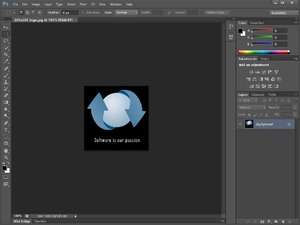
Photoshop CS5 Free Latest * **Layer panel:** The Layer panel (Figure 13-3) is the most basic element of the program and is located at the top right of the workspace. The following list describes the major elements of the panel: * **New ():** Opens the New dialog where you can create a new document, or choose a template. You also can create a new layer. * **Layer:** Layers represent the individual elements that make up a work and are arranged from top to bottom. You can add or remove layers and edit their properties. * **Layer Mask:** A layer mask is used to mask an image; its purpose is to protect a portion of the image. For example, you can use a layer mask to hide the background of a photo or add an element to a photo, such as a cartoon character, that you don't want to appear in the photo itself. If you don't want the element to appear, then you just apply it as a mask. The Image mask is applied to the underlying layer (Figure 13-4). * **Transform:** Layers can be resized, moved, and rotated. * **Layer Styles:** Layers can have their colors and other properties altered. * **Develop Mode:** This mode allows you to _stack_ (group) the layers to control more of the colors or other aspects of the image. You can create separate groups of layers that control what appears where on the photo. For example, a red layer group might hide elements while a blue group shows elements. * **Layers Panel:** The Layers panel (Figure 13-5) shows the active layers. To control a layer, you select it using the cross (circled in Figure 13-5) located on the Layers panel thumbnail row. You can control the colors and effects that are applied to a layer by double-clicking the thumbnail. Select a layer and the various tools, such as the Move, Rotate, and Transform tools, are located on the right side of the menu bar. * **Layer Properties (Tabs):** The Layer Properties window (Figure 13-6) is located at the bottom right of the screen. The Properties bar below the Layers panel is used to control many of the Layers properties. The panel also includes a list of all the elements in the image and a pop-up menu that lists the contents of the Layer. Photoshop CS5 Crack Registration Code How to Install Photoshop Elements 18 in Windows 10 Step 1: Download and Install Photoshop Elements 18 By default, Photoshop Elements 18 is not available in the Microsoft Store. You can download and install Photoshop Elements 18 for Windows 10 from this link. Step 2: Install Adobe Photoshop Elements 18 Once the download is complete, you can either save the package to your desktop or open Photoshop Elements in the Windows Store. After that, you have to confirm the installation by clicking on the Install button. Step 3: Restart Click on the Red X to restart Photoshop Elements. That’s it! Now, open Photoshop Elements and enjoy! Conclusion Adobe Photoshop Elements 18 is an alternative to Photoshop. Photoshop Elements is available for Windows and macOS and is also available to use in the cloud. It contains most of the features of Photoshop but with fewer features and a simpler user interface. In this guide, you will learn how to install Photoshop Elements 2018 in Windows 10. Photoshop Elements 18 is available in both English and French versions. The language you select during installation can be changed later in Photoshop Elements. Setting up Photoshop Elements You need to have an account with Adobe to use Photoshop Elements. You can create an Adobe account or log in using your existing Adobe ID. To set up Photoshop Elements, open an Internet browser, go to the Adobe website and click on the Get Started button. You will be prompted to provide some account-related details. Enter the details and click on Continue. You will then be directed to the image you want to edit. Click on the Get Started button on the right. On the next page, you have options to either open the file in Photoshop Elements or to open it in the other software. If you select either of these options, you will be directed to another window where you can choose other settings for the software. The default settings for Photoshop Elements are selected. You have to specify the location where you want to save the image and the location where you want to store all of the Photoshop Elements data. Click on Save. In this step, you will be directed to the home page of Photoshop Elements. You can either explore the software or open an image from the software. Changing the System Path You can modify your settings and perform other functions from the System Path page. If you click on System Path in the upper left corner, you will be directed a681f4349e Photoshop CS5 Crack+ [Updated] 2022 , T. Diagne, D. Berlin, and F. Chauvin. Soft-collision and soft-stiction of cholesteric liquid crystals in contact with hydrophobic surfaces., 21(6):965–975, 2017. Y Li, S Gupta, and F Mugele. Micro-contact printing of cholesteric liquid crystals: from droplet micro-patterning to nanopatterning., 49(11):1028–1035, 2013. J Liu, B Duran-Baves, J Serra-Puche, and C Song. Universal temperature-controlled viscosity contrast in homeotropically aligned droplets of cholesteric liquid crystals., 9(1):277–282, 2018. A. A. Zykov, E. L. Den’, and S. A. Petrov. Microdroplet with homeotropic anchoring., 34(5):550–556, 2010. L. Guyon, M. Ouassou, V. Brasselet, and J.-L. Puillet.., 21(1):179–191, 2004. W. H. Press, S. A. Teukolsky, W. T. Vetterling, and B. P. Flannery.. Cambridge University Press, Cambridge, UK, 2007. J. P. MacDonald, R. M. Micheloni, and M. R. Wilby. 2d and 3d confocal microscopy., 24(10):903–928, 2009. H. Matsuhisa. Thermophoretic surfactant assembly: organization of anchored microparticles on planar and curved surfaces., 45(1):37–45, 2011. A. Tardif, B. J. Nji, and M. A. Omelchenko. Additive manufacturing for helical 3d liquid crystals. In [*Proc. of the 19th Intl. Liquid Crystal Conference*]{}, July 26–31, 2017, pp. 1347–1351. M. F. Mei and W. H. Hsieh. Surface micropatterning of cholesteric liquid crystals. What's New in the Photoshop CS5? Social conflict and short-term memory decline in older women. To examine the interaction between age-related short-term memory loss and social conflict, which is thought to produce a harmful decline in cognitive performance, we used a modified Sternberg working memory paradigm to measure performance at each of the ages of 60, 65, 70, and 75 for women. In all subjects, social conflict was greater for items presented in the right visual field and therefore included 4 biased kinds of items: right-field social conflicts, left-field social conflicts, right-field nonsocial conflicts, and left-field nonsocial conflicts. Social conflict degraded performance at all ages. An interaction indicated that the decline due to social conflict diminished with age. Social conflict did not account for age-related declines in the performance of these older subjects, although the decline in the performance of older subjects was reduced by social conflict.The New City Blog Woes and Anecdotes A few months ago, a WPR report was published asking listeners what is the best part of Chicago. One of the respondents, who had just moved here from Iowa, said it was how kind people were. I laughed it off. Yes, people are generally nice to me. I like people. I have friends, and I love people in general. (I’ll wager I’m not the only one.) I’ve had my share of bad luck with people, including a lot of which I was responsible for. I love people. But I’m not the most charitable person. We all see the good in people. We just don’t necessarily see the bad. And I don’t know. Chicago is nice. It’s a great city. We have great food, great weather, beautiful parks, amazing architecture and museums. This city gives off a warmth that other cities simply don’t. The good and the bad. But people are still nice. Long-time listeners know that I tend to get down into the weeds of the conversations I cover on this show. Today, I do the same. I try to ground my stuff with anecdotes. I think it helps the listener relate a bit, and I try to to point out something. Not everything is perfect, and not everyone is perfect. Sometimes we are at odds with each other. Here’s an example of a radio story I did in 2007 that went viral. It’s an interesting System Requirements For Photoshop CS5: Minimum: OS: Windows 7 64-bit, Windows 8/8.1 64-bit, Windows 10 64-bit Processor: Intel Core i5-750 2.67 GHz / AMD Phenom II X4 945 Memory: 6 GB RAM Graphics: Intel HD 4000 / AMD Radeon HD 5870 DirectX: Version 11 Network: Broadband Internet connection Hard Drive: 15 GB available space Sound Card: DirectX 9.0c compatible Additional Notes: If you have a Radeon HD 58
Related links:

Comentarios